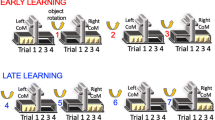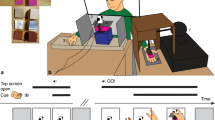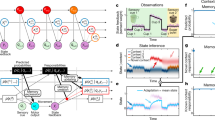Abstract
The temporal dynamics of the formation and decay of the memory processes underlying the specification of force when lifting objects of either the same or different weight were investigated. Sensorimotor memory enables rapid force programming to the physical object properties. Associative memory may be used to establish a memory link between a colour cue and object weight. In experiment 1, subjects lifted a constant weight in sets of ten lifts 10 s, 5 min, 1 h and 24 h apart. In experiment 2, subjects learned to associate a colour to two different weights to be lifted in alternation within sets of ten lifts 10 s, 5 min, 1 h and 24 h apart. Results of experiment 1 suggest that the memory related to the physical properties of a given object is rapidly established within a few lifts. However, there is a drift of accuracy of force programming that is observed as early as 10 s after the initial set of lifts. Results of experiment 2 imply that people are able to quickly establish an association between visual colour cues and particular object weights. Importantly, the formation of such memory appears to reduce the drift in accuracy observed in experiment 1 and provides the precise programming of grip and lift forces according to the physical object properties for up to 24 h.




Similar content being viewed by others
References
Cadoret G, Smith AM (1996) Friction, not texture, dictates grip forces used during object manipulation. J Neurophysiol 75:1963–1969
Cole KJ, Rotella DL (2002) Old age impairs the use of arbitrary visual cues for predictive control of fingertip forces during grasp. Exp Brain Res 143:35–41
Crovitz HF, Zener K (1965) A group for assessing hand and eye dominance. Am J Psychol 75:271–276
Davidson PR, Wolpert DM (2005) Widespread access to predictive models in the motor system: a mini review. J Neural Eng 2:313-319
Flanagan JR, Belzner MA (2000) Independence of perceptual and sensorimotor predictions in the size–weight illusion. Nat Neurosci 3:737–741
FlanaganJR, Johansson RS (2002) Hand movements. In: Ramshandran VS (ed) Encyclopedia of the human brain, vol 2. Academic, San Diego, pp 399–414
Gordon A, Forssberg H, Johansson R, Westling G (1991) Visual size cues in the programming of manipulative forces during precision grip. Exp Brain Res 83:477–482
Gordon A, Westling G, Cole K, Johansson R (1993) Memory representations underlying motor commands used during manipulation of common and novel objects. J Neurophysiol 69:1789–1796
Gordon A, Forssberg H, Iwasaki N (1994) Formation and lateralization of internal representations underlying motor commands during precision grip. Neuropsychologia 32:555–568
Jenmalm P, Johansson RS (1997) Visual and somatosensory information about object shape control manipulative fingertip forces. J Neurosci 17:4486–4499
Johansson RS (1996) Sensory control of dexterous manipulation in humans. In: Wing AM, Haggard P, Flanagan JR (eds) Hand and brain. Academic, San Diego, pp 381–414
Johansson RS, Westling G (1984) Roles of glabrous skin receptors and sensorimotor memory in automatic control of precision grip when lifting rougher or more slippery objects. Exp Brain Res 56:550–564
Johansson RS, Westling G (1988) Coordinated isometric muscle commands adequately and erroneously programmed for weight during lifting task with precision grip. Exp Brain Res 71:59–71
Nowak DA, Hermsdörfer J (2003) Sensorimotor memory and grip force control: does grip force anticipate a self-produced weight change when drinking with a straw from a cup? Eur J Neurosci 18:2883–2892
Nowak DA, Hermsdörfer J (2006) Objective evaluation of manual performance deficits in neurological movement disorders. Brain Res Rev 51:108–124
Nowak DA, Rosenkranz K, Hermsdörfer J, Rothwell JC (2004) Memory for fingertip forces: passive hand muscle vibration interferes with predictive grip force scaling. Exp Brain Res 156:444–450
Quaney BM, Rotella DL, Peterson C, Cole KJ (2003) Sensorimotor memory for fingertip forces: evidence for a task-independent motor memory. J Neurosci 23:1981–1986
Quaney BM, Perera S, Maletsky R, Luchies CW, Nudo RJ (2005) Impaired grip force modulation in the ipsilesional hand after unilateral middle cerebral artery stroke. Neurorehabil Neural Repair 19:338–349
Raghavan P, Krakauer JW, Gordon AM (2006) Impaired anticipatory control of fingertip forces in patients with a pure motor or sensorimotor lacunar stroke. Brain 129:1415–1425
Salimi I, Hollender I, Frazier W, Gordon A (2000) Specifity of internal representations underlying grasp. J Neurophysiol 84:2390–2397
Sinnaeve A, Dubrowski A, Carnahan H (2002) Evidence for the use of both iconic and long-term memory systems for friction when grasping. Soc Neurosci Abstr 28:268.4
Wolpert DM, Ghahramani Z, Jordan MI (1995) An internal model for sensorimotor integration. Science 269:1880–1882
Wolpert DA, Kawato M (1998) Multiple paired forward and inverse models for motor control. Neur Netw 11:1317–1329
Wolpert DM, Ghahramani Z (2000) Computantional principles of movement neuroscience. Nat Neurosci 3:1212–1217
Acknowledgments
The research is part of the second authors’ (C. K.) dissertation at the Ludwig, Maximilians, University of Munich, Germany.
Author information
Authors and Affiliations
Corresponding author
Rights and permissions
About this article
Cite this article
Nowak, D.A., Koupan, C. & Hermsdörfer, J. Formation and decay of sensorimotor and associative memory in object lifting. Eur J Appl Physiol 100, 719–726 (2007). https://doi.org/10.1007/s00421-007-0467-y
Accepted:
Published:
Issue Date:
DOI: https://doi.org/10.1007/s00421-007-0467-y




